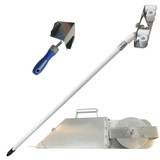Description
Introducing "The Original" Bloomington Banjo. This banjo is one of the most solid built banjos on the market today. It can hold 500 linear feet rolls of tape, with an adjustable mud flow dam in front, and an easy to fill mud compartment. Made in Bloomington, Minnesota.
Details
Length: |
16 |
Hose Length: |
35' Hose |
Stand: |
No |
Manufacturer: |
Bloomington |
Product Reviews
-
Left handed
Same as Mike has asked, I’ve been using left handed Bloomington banjos for close to 20 years. But I can’t find them anymore and need a new one BAD. Can ANYBODY get them?? Thank you
-
Bloomington banjo
I really like the Bloomington banjo but i can't seem to find a left handed banjo... is it possible to get one directly from Bloomington? Thankyou Mike Morton










